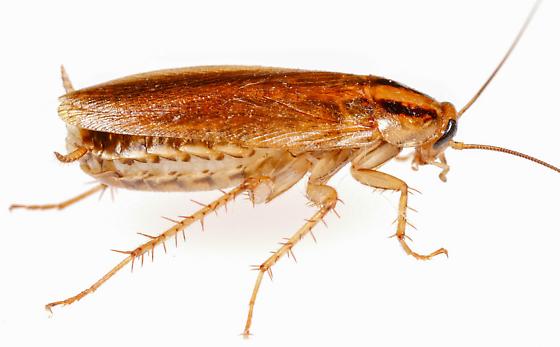Cockroaches (Blattodea) are related to praying mantis and termites with which they form the super order Dictyoptera. The name would come from the Portuguese cacalacca. The Spanish version also sounds familiar: la cucaracha.
They resemble beetles with an oval flattened body, six thorny legs and two mobile, long feelers. They can run fast: more than 5 km / h or about 83 meters per minute, with a top speed of 1.5 meters per second. That would be a human sprint of over 300 kilometers per hour! They are usually brown to black. Twenty of the 4.690 species described may occasionally occur as plague. In the Low Countries, these are usually the German cockroach (Blattella germanica), the American or large cockroach (Periplaneta americana) or the Oriental cockroach, also called waterbug or black beetle (Blatta orientalis).
Cockroaches are omnivores. they can up to 2 months without food, and 1 to 2 weeks without water. They are especially active at night.
 During the day they crawl away from light and hide in dark seams and cracks. They love temperatures from 20 to 30 ° C and sufficient humidity such as behind the refrigerator, in and behind kitchen cupboards, in ducts, bathroom, drainage pits, basements and in the vicinity of household waste and food remains. Even in appliances they find the warm light of the standby button.
During the day they crawl away from light and hide in dark seams and cracks. They love temperatures from 20 to 30 ° C and sufficient humidity such as behind the refrigerator, in and behind kitchen cupboards, in ducts, bathroom, drainage pits, basements and in the vicinity of household waste and food remains. Even in appliances they find the warm light of the standby button.
A female cockroach carries about thirty cockroaches in an egg packet that is deposited after 3 to 5 weeks (depending on the temperature and the food supply). That cockroaches lay their eggs when you kill them is erroneously based on the fact that they drop their egg packets when they feel threatened.
In fact they are harmless to humans, but they can transmit bacteria and diseases by eating food and polluting it.
A plague at home is difficult to combat. Cockroaches have survived for around 200 million years in the harshest conditions. They can not survive an atomic explosion (as was sometimes claimed), but they can withstand much higher amounts of radiation than humans. They hide (especially during the day) and are quickly poison-resistant. Traces can be found, for example, as egg packages or leftovers from the larvae cocoons.
Cockroaches also often are moulting. This looks like a transparent capsule, usually near their shelters.
Their droppings resemble leftover coffee and are 1 millimeter long. They spread an unpleasant odor (but not specifically when trampled, which is often claimed).
You can catch them (like snails) by placing a slightly wet mop. That ideal shelter you can then empty in a tub in the morning.
An efficient and non-toxic trapping method is the "Vegas roach trap": a glass jar with narrow opening, partly filled with coffee grounds (and some water). On the outside, eventually rough adhesive tape, so that the cockroaches can easily climb inside. The "Vegas roach trap" is insect-friendly because it does not attract other insects.
- Or put dishes with water and oil, they drink from it, the oil clogs the airways causing them to drown. Cockroaches can hold their breath for 40 minutes and survive 30 minutes under water. They do not breathe through the mouth, but through siphons, small 'tubes' in their bodies that they can keep shut.
- Onion and boric acid: make a paste of a finely chopped medium-sized onion, 1/2 cup of ordinary flour, some water or beer, a little sugar and 3-4 teaspoons of boric acid powder and distribute it (unreachable for pets).
- Baking soda and sugar: mix same quantity of both. The baking soda will cause deadly gas bubbles in their body.
- Borax: sprinkle this natural ingredient around their shelters. It affects their scale, causing them to dry out.
- Mix icing sugar and gypsum powder and place a cup of water next to it. The gypsum powder will clump and harden in the stomach of the cockroaches, causing them to die.
Cockroaches do not like catnip or laurel leaves.
The rather large, sizzling Madagascar cockroach is often kept as a pet, and is (fried, cooked ..) edible.
